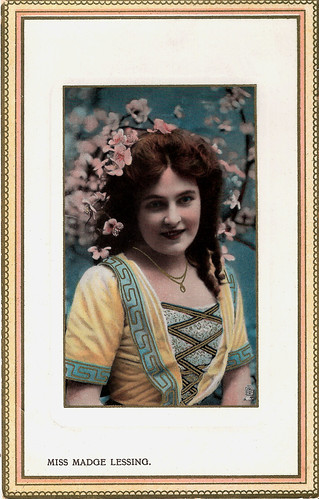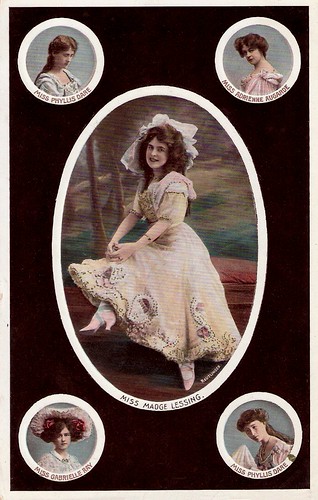During the Belle Epoque, Madge Lessing (1866-1932) celebrated many successes in European theatres and also on Broadway. In the 1910s, the British actress and singer also made some silent films in Germany.

British Postcard by Raphael Tuck & Sons in the series Framed Gem, no. 5773, ca. 1912.

British postcard by H. Vertigen & Co., London, Series no. 6204. In the center: Madge Lessing. From left under the clock: Gabrielle Ray, Phyllis Dare, Adrienne Augarde and again Phyllis Dare.

British postcard by Ed. Gottschalk, Dreyfus & Davis, London, in the Star Series.
Madge Lessing was born as Margaret O'Donnell in London in 1873 to Irish parents Catherine (née Buckley) and James Patrick O'Donnell, an assurance agent. In interviews, she claimed that she had run away from home to go on the stage. Around 1890, she travelled from London to the United States where she was a chorus girl at Koster and Bial's Music Hall in New York.
After only three weeks she was promoted to the title role in the burlesque 'Belle Helene'. Her next role was with the Solomon Opera Company followed by appearances as Chollie Keal in 'The Passing Show' (1894). In May 1896 she opened the musical revue 'In Gay New York' at the Casino Theatre in New York. It was written by C. M. S. McLellan, who would later become her brother-in-law. She had a successful role as the principal boy Jack Hubbard in Klaw and Erlanger's extravaganza 'Jack and the Beanstalk' which ran for 64 performances at the Casino Theatre in New York in 1896 and in 1898 at the Boston Museum in Boston and the Lafayette Square Opera House in Washington, D.C.
In 1899 she played in 'A Dangerous Maid' for 64 performances at the Casino Theatre in New York, while in Boston at Christmas 1899 she appeared as 'Little Boy Blue' in 12 performances of the children's pantomime 'Little Red Riding Hood' which in early January 1900 moved on to the Casino Theatre in New York, the home of the Broadway adult musical, where the production was transformed with additional female actresses added to the cast in scanty costumes and more risqué songs to cater for an adult audience. Next, Lessing succeeded Mabelle Gilman as 'Priscilla' in the vaudeville 'The Rounders' (1900) at the Columbia Theatre in Boston.
On Christmas 1900, Lessing made her London début as Princess Beauty in the annual children's pantomime 'The Sleeping Beauty and the Prince' at the Theatre Royal Drury Lane which ran for 134 performances. In 1901 she played Dimples in 'The Whirl of the Town' and Violet Gray in the first revival of 'The Belle of New York' at the Adelphi Theatre in London in 1902. She appeared on the bill at the opening of the London Coliseum Theatre of Varieties in 1904 on a variety programme in which she sang 'Goodbye, Little Girl', 'My Irish Molly O' and several other popular hits of the time.
Her other roles during this period include the title role in 'Em'ly' (an adaptation of 'David Copperfield') at the Adelphi Theatre (1903), Jill opposite Dan Leno and Herbert Campbell in the pantomime 'Mother Goose' at the Theatre Royal Drury Lane (1902) and appearances in 'Erminie' at the Casino Theatre in New York (1903); 'Wang' (1903) with the DeWolf Hopper Opera Company; 'Sergeant Brue' at the Prince of Wales Theatre in London, (1904); Elsie in 18 matinee performances of the piratical tale 'Noah's Ark' at the Waldorf Theatre in London (1906) in which "Miss Madge Lessing laughed and danced and sang very charmingly, and seemed to enjoy everything quite as much as the children on the stage or in the front of the house"; 'The Prince of Pilsen' (1907-1908) at the Olympia Theatre in Paris, and 'Halloh!' (1909) at the Berlin Metropol.

British postcard by Raphael Tuck & Sons Real Photograph Post Card, no. T 708. Photo: Dover Street Studios.

British postcard by Rotary, no. 167 h.

British postcard by The Philco Publishing Co., London, Series no. 3365 D. Sent by mail in 1907. Photo: Dover Street Studios.
Madge Lessing’s film career began in 1913 and was concentrated exclusively in Germany. In 1910 the musical comedy star was a sensation in Berlin when she appeared as a a modern dandy in a stage production at the Metropol Theater.
Her film debut was the comedy Wo ist Coletti?/Where is Coletti? (Max Mack, 1913), a Vitascope production starring Hans Junkermann. The plot is set in motion when Detective Coletti (Junkermann) goes into hiding, posting a 25,000-dollar reward for anyone who can ascertain his whereabouts within 48 hours. Among those eagerly searching for the missing gumshoe is Coletti's sweetheart, played by Lessing.
Hal Erickson at AllMovie: "In one scene, the incognito detective attends a moving picture show, permitting the director the opportunity to stage a film-within-a-film (a sequence that impressed the reviewer for Variety). A trick ending caps this inconsequential rib-tickler."
Madge Lessing’s film debut was soon followed by Die blaue Maus/The Blue Mouse (Max Mack, 1913) with Heinrich Peer. In the next years, she appeared in a few more films including Die Welt ohne Männer/The World Without Men (Max Mack, 1914), Die blaue Maus, 2. Teil/The Blue Mouse, Part 2 (Max Mack, 1915; banned in Germany till 1919) and Fritzis toller Einfall/Fritzi's Great Idea (Max Mack, 1916) again with Hans Junkermann and with Senta Söneland.

British Postcard by Raphael Tuck & Sons in the series Framed Gem, no. 5773, ca. 1912.

British postcard by H. Vertigen & Co., London, Series no. 6204. In the center: Madge Lessing. From left under the clock: Gabrielle Ray, Phyllis Dare, Adrienne Augarde and again Phyllis Dare.

British postcard by Ed. Gottschalk, Dreyfus & Davis, London, in the Star Series.
Run away from home to go on the stage
Madge Lessing was born as Margaret O'Donnell in London in 1873 to Irish parents Catherine (née Buckley) and James Patrick O'Donnell, an assurance agent. In interviews, she claimed that she had run away from home to go on the stage. Around 1890, she travelled from London to the United States where she was a chorus girl at Koster and Bial's Music Hall in New York.
After only three weeks she was promoted to the title role in the burlesque 'Belle Helene'. Her next role was with the Solomon Opera Company followed by appearances as Chollie Keal in 'The Passing Show' (1894). In May 1896 she opened the musical revue 'In Gay New York' at the Casino Theatre in New York. It was written by C. M. S. McLellan, who would later become her brother-in-law. She had a successful role as the principal boy Jack Hubbard in Klaw and Erlanger's extravaganza 'Jack and the Beanstalk' which ran for 64 performances at the Casino Theatre in New York in 1896 and in 1898 at the Boston Museum in Boston and the Lafayette Square Opera House in Washington, D.C.
In 1899 she played in 'A Dangerous Maid' for 64 performances at the Casino Theatre in New York, while in Boston at Christmas 1899 she appeared as 'Little Boy Blue' in 12 performances of the children's pantomime 'Little Red Riding Hood' which in early January 1900 moved on to the Casino Theatre in New York, the home of the Broadway adult musical, where the production was transformed with additional female actresses added to the cast in scanty costumes and more risqué songs to cater for an adult audience. Next, Lessing succeeded Mabelle Gilman as 'Priscilla' in the vaudeville 'The Rounders' (1900) at the Columbia Theatre in Boston.
On Christmas 1900, Lessing made her London début as Princess Beauty in the annual children's pantomime 'The Sleeping Beauty and the Prince' at the Theatre Royal Drury Lane which ran for 134 performances. In 1901 she played Dimples in 'The Whirl of the Town' and Violet Gray in the first revival of 'The Belle of New York' at the Adelphi Theatre in London in 1902. She appeared on the bill at the opening of the London Coliseum Theatre of Varieties in 1904 on a variety programme in which she sang 'Goodbye, Little Girl', 'My Irish Molly O' and several other popular hits of the time.
Her other roles during this period include the title role in 'Em'ly' (an adaptation of 'David Copperfield') at the Adelphi Theatre (1903), Jill opposite Dan Leno and Herbert Campbell in the pantomime 'Mother Goose' at the Theatre Royal Drury Lane (1902) and appearances in 'Erminie' at the Casino Theatre in New York (1903); 'Wang' (1903) with the DeWolf Hopper Opera Company; 'Sergeant Brue' at the Prince of Wales Theatre in London, (1904); Elsie in 18 matinee performances of the piratical tale 'Noah's Ark' at the Waldorf Theatre in London (1906) in which "Miss Madge Lessing laughed and danced and sang very charmingly, and seemed to enjoy everything quite as much as the children on the stage or in the front of the house"; 'The Prince of Pilsen' (1907-1908) at the Olympia Theatre in Paris, and 'Halloh!' (1909) at the Berlin Metropol.

British postcard by Raphael Tuck & Sons Real Photograph Post Card, no. T 708. Photo: Dover Street Studios.

British postcard by Rotary, no. 167 h.

British postcard by The Philco Publishing Co., London, Series no. 3365 D. Sent by mail in 1907. Photo: Dover Street Studios.
The outstanding Max Mack
Madge Lessing’s film career began in 1913 and was concentrated exclusively in Germany. In 1910 the musical comedy star was a sensation in Berlin when she appeared as a a modern dandy in a stage production at the Metropol Theater.
Her film debut was the comedy Wo ist Coletti?/Where is Coletti? (Max Mack, 1913), a Vitascope production starring Hans Junkermann. The plot is set in motion when Detective Coletti (Junkermann) goes into hiding, posting a 25,000-dollar reward for anyone who can ascertain his whereabouts within 48 hours. Among those eagerly searching for the missing gumshoe is Coletti's sweetheart, played by Lessing.
Hal Erickson at AllMovie: "In one scene, the incognito detective attends a moving picture show, permitting the director the opportunity to stage a film-within-a-film (a sequence that impressed the reviewer for Variety). A trick ending caps this inconsequential rib-tickler."
Madge Lessing’s film debut was soon followed by Die blaue Maus/The Blue Mouse (Max Mack, 1913) with Heinrich Peer. In the next years, she appeared in a few more films including Die Welt ohne Männer/The World Without Men (Max Mack, 1914), Die blaue Maus, 2. Teil/The Blue Mouse, Part 2 (Max Mack, 1915; banned in Germany till 1919) and Fritzis toller Einfall/Fritzi's Great Idea (Max Mack, 1916) again with Hans Junkermann and with Senta Söneland.
All her films were made by the outstanding Max Mack, who directed 127 films between 1911 and 1935. After Lessing returned to England she only worked on stage. She died in 1931 at the age of 69. Madge Lessing was married to the stage manager George B. McLellan, the brother of writer C.M.S. McLellan.

German advertising postcard by Richard Habisch & Co., Berlin, for Gargoyle Bohner Wasch, sent by mail in 1911. Photo: Ernst Schneider, Berlin.

British postcard by Rotary, no. 167 M. Photo: Johnston & Hoffmann.

British postcard by The Rapid Photo printing Co. Ltd., London, no. 2363.
Sources: Thomas Staedeli (Cyranos), Hal Erickson (AllMovie - Page now defunct) and IMDb.
This post was last updated on 18 March 2025.
No comments:
Post a Comment